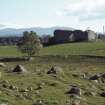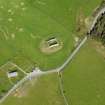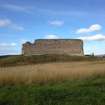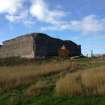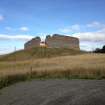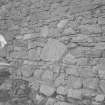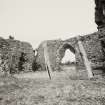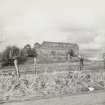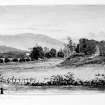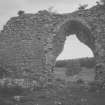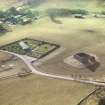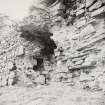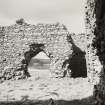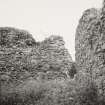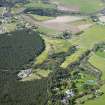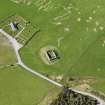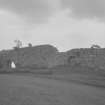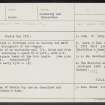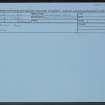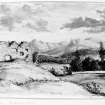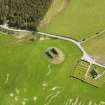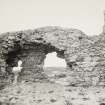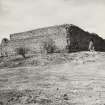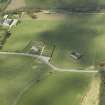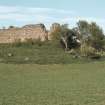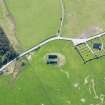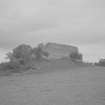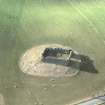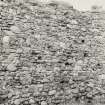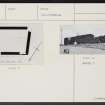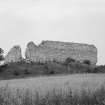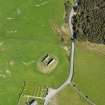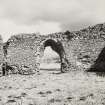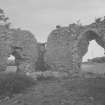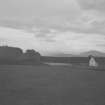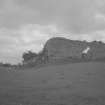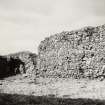Castle Roy
Castle (Medieval)
Site Name Castle Roy
Classification Castle (Medieval)
Canmore ID 15715
Site Number NJ02SW 1
NGR NJ 0065 2192
Datum OSGB36 - NGR
Permalink http://canmore.org.uk/site/15715
- Council Highland
- Parish Abernethy And Kincardine
- Former Region Highland
- Former District Badenoch And Strathspey
- Former County Inverness-shire
NJ02SW 1.00 NJ 0065 2192.
NJ02SW 1.01 NJ 006 218 Geophysical Survey; Trial Excavation
(NJ 0065 2192) Castle Roy (NAT).
OS 6"map, Inverness-shire, 2nd ed., (1903)
A simple 13th century fortress with no history but said to have been a stronghold of the Comyns. It consists of an enclosing wall 7ft thick and from 10-15ft high enclosing a space 80 x 53ft, with a N doorway and a square tower at the NW angle.
Late 12th to early 13th century. (J G Dunbar 1966)
D MacGibbon and T Ross 1887-92; J G Dunbar 1966.
The remains of Castle Roy are as described and planned by MacGibbon & Ross.
Visited by OS (NKB) 7 September 1966.
The remains of the site are as described above.
Visited by RCAHMS (AGCH) 24 October 2006.
Watching Brief (9 December 2012 - 25 January 2013)
NJ 0065 2192 A trial trenching evaluation was carried out, 9 December 2012 – 25 January 2013, following a programme of work in 2012 (DES 2012, 90). Two trenches were excavated inside the castle walls, to the SW and NE (interventions 7 and 8). The structural remains and artefacts recorded in both trenches enhanced understanding of the position and form of buildings and provided evidence of activity within the castle.
Evidence of a timber building, with a possible solid lime mortar floor, was recorded in the first trench (intervention 7). A small remnant of the floor surface was recorded close to the SW corner of the castle. The floor was contemporaneous with a square posthole and both features overlay subsoil, which suggests they may belong to an early phase of occupation. A stone plinth and mortar flecking recorded in nearby deposits may indicate a building aligned NE–SW along the NW of the castle interior. Accompanying material consisted of an assemblage of animal bone which, while small, represented a diverse range of species of domesticated and wild animals, providing a glimpse of the high status lifestyle enjoyed by the inhabitants of the castle.
The second trench (intervention 8) provided evidence for a building in the NE corner of the castle, perhaps extending along the SE wall. The remains of stone features and structural ironwork provided evidence of a timber frame. An arrangement of cobbles of unknown function was also recorded.
An examination of the extant fabric of the walls indicated the presence of a range of buildings along the SE wall, which incorporate a substantial horizontal recess set at a fairly high level. This has been interpreted as a wall plate recess, indicating the presence of a fairly high first-floor level within an internal building, which ran the full length of the curtain wall. The lack of window openings and garderobe features suggests that this building may have been a service range and/or stables with storage above.
Archive: FAS Heritage
Funder: Castle Roy Trust
Justin Garner-Lahire, FAS Heritage, 2013
(Source: DES)
Excavation (31 October 2012 - 2 November 2012)
NJ 0065 2192 A programme of archaeological work was carried out 31 October – 2 November 2012 prior to conservation work at Castle Roy. The work consisted of:
A photographic and measured survey (phase 1).
The excavation of two sondages through the mound to the exterior of the castle, to assess its composition and assess the condition of the castle’s foundations (phase 2–3). The first measured 3.3 x 0.6 x 1.2m deep and was positioned against the NE curtain wall. The second measured 2.75 x 0.6 x 1.1m deep and was positioned against the NW curtain wall.
The excavation of a trench along the N exterior elevation of the square tower (phase 4).
The excavation of a trench close to the exterior NW corner of the castle, to define the layout of a putative garderobe turret thought to project from the curtain wall (phase 5).
A watching brief during the excavation of the pits through the mound recorded subsoil at 0.6–0.8m below the current ground surface, overlain by topsoil. This evidence suggests that that the castle had been constructed on a natural glacial hill, rather than a man-made mound.
The foundations of the curtain walls were found to be fairly shallow and were built on a topsoil deposit rather than natural subsoil. The NE wall foundation consisted of three courses of unbonded angular masonry, splayed to form a 50° chamfer. The foundation of the NW wall consisted of a single course, projecting 0.2m from the face of the castle. The difference in the construction technique used for the NE and NW curtain walls is noteworthy. While it is possible that these differences in the foundations may represent a chronological sequence in the development of the castle, it may simply have been a result of the relative importance of the NE wall being the principal face of the castle containing a substantial and fairly impressive door opening.
Various structural features were noted, which hint at the form of the now vanished internal buildings of the castle. The mural chamber in the W corner of the castle includes a short length of vaulting projecting from the external elevation of the NW curtain wall. Adjacent to this projection, the remains of a garderobe chute issuing from the level above also survive. The presence of a first floor level in this corner of the castle is also indicated by the remains of one side of a window opening. These features suggest that this corner of the castle contained a two-storey building lit at first floor level by at least one window, and served by a mural garderobe chamber on each floor. The vaulting projecting out of the castle strongly suggests that the mural garderobe chambers would have formed a turret projecting from the elevation of the curtain wall.
The presence of the large arched window opening at the E end of the NW curtain wall indicates that this putative two-storey internal building did not extend along the full length of the curtain wall. The height of this window suggests that the internal building in this area was single storey, and may have been a hall with a two-storey solar range to the SW. If this is the case, the two-storey tower at the N corner of the castle would have been accessed at ground-floor level from the hall.
The SE curtain wall survives to a greater height than the opposing long wall of the castle. While this elevation does not include any obvious window openings, it does contain a substantial horizontal recess set at a fairly high level. Although this recess was filled suggesting a later phase of adaptation, the stone and mortar fill has partially collapsed revealing the original feature. This recess appears to be too substantial to represent a roof scar, and has been interpreted as a wall plate recess which would indicate the presence of a fairly high first-floor level within an internal building running the full length of the curtain wall. The lack of window openings and garderobe features suggests that this building may have been a service range and/or stables with storage above.
The lack of evidence for internal buildings at the NE and SW ends of the castle should not be taken as proof that internal buildings did not exist in these areas. It should also be noted that the remains of external castle buildings may well exist in the immediate environs of the standing building.
Funder: Castle Roy Trust
Justin Garner-Lahire, FAS Heritage,2012
(Source: DES)
Watching Brief (June 2013 - July 2013)
NJ 0065 2192 A programme of work was carried out in June and July 2013 to prepare for works to conserve and consolidate the castle. A watching brief was undertaken to supervise an area of stripping for a contractors compound, access track and borrow pit. All excavations were outwith the scheduled area, but close to the castle. No finds or features of archaeological significance were recorded. There was evidence of fairly recent rough levelling.
An electricity pole was moved from the scheduled area to a site further from the castle, to improve the visual setting, and an underground cable laid across the field to the compound area. The only feature noted was a modern (plastic) field drain. It is thought that extensive ploughing has damaged or removed much of the archaeology in this area.
Areas of rubble were removed from the interior of the castle, with care taken to avoid any kind of ground-breaking in order to preserve the topsoil and any features.
A resistivity survey of the interior of the castle and selected external areas was undertaken by OJT Heritage on 2 August 2013. This found that the area was heavily disturbed with various areas of sub-surface rubble and clearance. There was, however, some indication of groundworks immediately outside the castle entrance, which were possibly associated
with its construction, and also possible foundations for a leanto type building along the inside SE wall.
A watching brief was undertaken, 7–10 August 2013, during the removal of turf within the castle and through the entrance to the compound area. No finds or features of archaeological significance were recorded, and the topsoil was left in place to protect underlying remains.
A photographic survey was undertaken to update and complement the previous work by FAS Heritage before consolidation works. In addition, interactive panoramas and photosynths were produced in order to aid navigation of these records.
Consolidation works of the wall heads then began in March 2014. In this process the turf and loose soil was removed from a short section of wall head, the underlying stonework recorded, and the wall capped with lime mortar. It was noted that soil had often worked its way down through the rubble core of the wall.
Several features, which had previously been hidden by foliage, became apparent including window reveals, an intramural passage and a garderobe. To date, these features have all been revealed on the W side of the castle and confirm that there were internal buildings set against the walls in this area which were at least two-storeys high. It also confirms that the walls were significantly higher during the use of the castle and that many features have been entirely lost.
The removal of three banked areas of rubble pressing against the external walls was monitored, 3–7 April 2014. Areas 1 and 3 lie to the immediate N and S of the entrance, respectively. Area 2 forms the tumbled S corner of the castle.
In Area 1 a mound 1m high was removed from outside the castle wall. This was found to consist of mostly rounded stones with a few small pieces of mortar, daub and animal bone. One fragment of dressed sandstone was recorded, a door jamb with typical angled facing.
In Area 2 turf, topsoil and loose stones were removed by hand to reveal the base of a wall running slightly off of the alignment of the surviving wall. The external facing of this wall was clearly visible, and abutting the internal face was a dump of mortar in situ. The interior rubble was largely floating
within loamy soil and this was not excavated below the level of the surviving facings. Several finds were recovered from the topsoil including hand made nails and a small piece of slag. There were also various animal bones, many of which showed clear butchery marks.
Area 3 was another small mound of rubble against the external wall just to the SE of the entrance. It consisted of a shallow topsoil 0.4m deep at its maximum, with few rounded stones of c40–100mm in diameter. The area was carefully lowered using a back-acting arm of a JCB under supervision,
but subsoil was not reached and no further work was undertaken in this area.
Archive: HAS. Report: Highland HER
Funder: Castle Roy Trust
Lynne McKeggie - Highland Archaeology Services
(Source: DES)
Conservation (July 2017 - December 2021)
NJ 0065 2191 Castle Roy (SM 952; Canmore ID: 15715) is located on the N side of Nethy Bridge in Strathspey. Between July 2017 and December 2021, archaeological monitoring was required for a programme of repair, consolidation, and development works, which followed on from previous survey, investigation, and monitoring works undertaken from 2012 to 2014. Four phases of works were carried out under Scheduled Monument Consent, including re-building, structural repairs, and consolidation of the monument, the addition of two viewing platforms, the addition of a path network around and within the castle, and installation of interpretation panels on the site. The works are now completed and have resulted in a safe and accessible monument for public enjoyment and long-term preservation of the structure.
Castle Roy is a simple courtyard castle comprising a single curtain wall built in the late-12th to early-13th centuries on a natural glacial mound. Consolidation works comprised repairs of the existing walls, including masonry repairs, some re- building, and insertion of steel plates to stabilise the two arched entrances and the garderobe chamber. Several structural features were present, including a garderobe chute and window alcoves indicating internal two-storey structures. The works also highlighted differences in the construction of the foundations, with a single course of unbonded stonework projecting from the NW and SE walls, compared to three courses of unbonded stonework splaying to form a chamber at the NE wall. This difference is thought to indicate the relative importance of the NE wallface as the main entrance to the castle.
Evidence for internal structures has been highlighted by previous
phases of works during 2012–2014, indicating the presence of a two-storey structure along the NW side of the castle, associated with the garderobe, and a full-length structure along the SE side. During the current phase of consolidation, only minimal groundbreaking was carried out, but the presence of two postholes was identified along the SE wall. These were not excavated but they may represent timber supports for the building in this location.
As well as consolidation of the monument, the works included the development of the monument into an accessible site. A path network was constructed around the base of the mound and through the two main arched entrances. Within the courtyard, a circular path surrounding a grassed area was created. To the N of the castle, a small picnic area was established. Two viewing platforms were constructed, one at the breach in the S angle and a second on the first fl oor of th e tower in th e N angle, wh ich is accessed by wooden steps.
Archive: NRHE (intended) Funder: Castle Roy Trust
Lindsey Stirling – AOC Archaeology Group
(Source: DES Volume 23)
Mortar Analysis
NJ 0065 2192 A programme of landscape, buildings and materials analysis is being carried out at Castle Roy within the framework of this project. Buildings analysis at Castle Roy indicated that the constructional masonry of the curtain wall and tower is characterised by a series of distinctive rubble-built through-courses, bound with a wood-fired limestone-lime mortar. The consistent character of the surviving masonry visible at low- and mid-levels suggests the building is predominantly single phase. To enable further lab-based investigation of these materials, a programme of materials sampling was undertaken. The sample assemblage included 26 relict fuel inclusions, 4 core mortar fragments, 2 relict limestone clasts, and a single loose (ex situ) fragment of sandstone. Samples of possible source materials were also collected from various local quarry, kiln and riverine contexts during landscape survey, to allow comparative analysis with the buildings assemblage.
Lab-based analysis of the Castle Roy assemblage included comparative microscopic thick and thin section analysis of all mortar and relict limestone samples. These analyses highlighted the homogeneity of the mortar assemblage consistent with previous single-phase interpretations of the upstanding building. They also suggested that the meta-limestone lime-source of this mortar was consistent with a local Grantown Marble Formation outcrop, whilst the aggregate temper was consistent with materials collected from a nearby river.
Archaeobotanical analysis suggested the relict fuel assemblage was dominated by wood-charcoal of various taxonomies, and five well-distributed relict fuel samples were selected for radiocarbon analysis.
Archive: NRHE (intended)
Funder: University of Stirling and Historic Environment Scotland
Mark Thacker – University of Stirling
(Source: DES Vol 19)















































